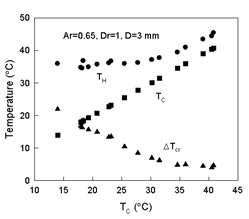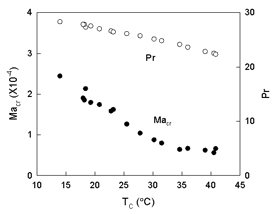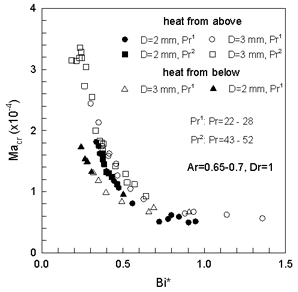|
||||||
Y. Kamotani1, L. Wang1, S. Hatta1, P. Bhunia1, and S. Yoda2
1Case Western Reserve University, Cleveland, OH 44106, USA
2National Space Development Agency of Japan, Tsukuba, Ibaraki, Japan
Much work has been done in the past on oscillatory thermocapillary flows, both theoretically and experimentally. However, the cause of oscillatory flow for high Prandtl number (Pr) fluid is not yet fully understood. Much experimental information is available concerning the condition for the onset of oscillations in the so-called half-zone (or liquid-bridge) configuration with high Prandtl number fluids. These data have been taken by many investigators under various conditions with various experimental procedures. One reason for the lack of full understanding of the oscillation phenomenon is that those data are not very consistent. In the present work we show that the effect of heat transfer from the free surface, which has been largely neglected in the past, can affect the critical condition significantly.
The effect of surrounding air motion on oscillatory thermocapillary flows is studied experimentally herein. Thermocapillary flows in liquid bridges and circular containers are investigated. The air motion is due to the natural convection of air caused by the heating-cooling arrangement of the experiment and also due to the forced convection associated with the motion of the liquid free surface. No externally forced air motion is considered. The air motion is varied in the present experiment by changing the cold wall temperature relative (TC) to the ambient air temperature (TR). The conditions for the onset of oscillations are investigated under variable free surface heat transfer. The air motion is also simulated numerically in order to determine the heat transfer rate at the liquid free surface.
In the half-zone configuration, 2 and 3 mm diameter liquid columns of 2 and 5 cSt silicone oils are tested. The free surface shape is flat or concave. In some tests the apparatus is placed in an oven to vary the ambient temperature. In the circular cylinder configuration (or the STDCE configuration), a 1.2 cm diameter container filled with 2 cSt silicone oil is used. Only flat free surface is investigated in the STDCE configuration.
It is found that in the case of concave liquid bridge (the diameter ratio of less than 0.8), the critical Marangoni number (Macr) is virtually unchanged when TC is varied relative to TR, which one would expect when Ma is the main dimensionless parameter. In contrast, when the free surface is nearly flat, the effect of TC on Macr is very much different. As shown in Fig. 1, the hot wall temperature (TH) at the critical condition remains nearly constant over a certain range of TC, which means that Macr decreases with increasing TC. This change of Macr is substantial, as seen in Fig. 1. The same trend is found in other tests with flat free surfaces, as well as in the STDCE configuration.


Fig. 1 Critical conditions in half-zone configuration with flat free surface
The above effect of TC is shown to be caused by the surrounding air motion. By changing TC relative to TR, we are changing the natural convection of the air. It is shown that Macr is affected also by placing an external object around the liquid column (without touching it), thereby altering the airflow. The airflow is quite weak, on the order of a few cm/s, so it has been neglected in the past.
It is very difficult to measure the heat transfer rate at the free surface associated with such a slow airflow accurately. For the reason, the heat transfer rate is computed numerically. The analysis shows that the airflow pattern and magnitude change as we change TC, TR, and TH. The main quantity of interest is the modified Biot number (Bi*). Bi* is an appropriate measure of how much the basic flow is affected by the surface heat loss in the present configuration. The values of Macr is correlated with Bi* in Fig. 2 for the half-zone configuration. As the figure shows, Macr decreases with increasing Bi*. A similar result is obtained for the STDCE configuration.

Fig. 2 Macr versus Bi* for half-zone configuration
By examining the result of Fig. 2 closely, one finds some unusual things. (1) According to the numerical simulation, Macr decreases despite the fact the convection in the liquid decreases. (2) Following the critical condition, as Bi* increases, the actual heat loss decreases. Bi* increases because Ma decreases faster than the heat loss. (3) A large Macr change occurs in a rather small range of Bi*: Macr changes by a factor of about two when Bi* is varied from 0.25 to 0.35. It can be shown that the change in the basic flow field is quite small when Bi* is varied from 0.25 to 0.35. Those facts imply that the present heat loss effect cannot be explained only by the change in the basic flow. We must consider an additional factor to explain the effect as well as the oscillation mechanism.
The present work tells us that it is very important to know the condition of the ambient condition when one compares various data on the onset of oscillations for high Prandtl number fluids.

|